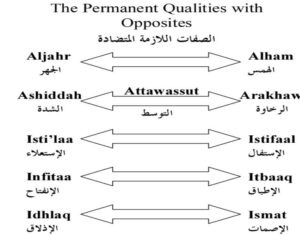Sifaat with Opposites in Tajweed: Unlocking the Nuances of Quranic Recitation
Understanding the Subtle Characteristics of Arabic Letters
The art of Tajweed, the precise and melodious recitation of the Quran, is a sacred endeavor for Muslims worldwide. It involves mastering the correct pronunciation, intonation, and characteristics of each Arabic letter. Among the essential concepts within Tajweed are the “Sifaat”—the unique attributes that distinguish one letter from another.
What Are Sifaat with opposites and without?
Sifaat refer to the inherent characteristics of Arabic letters. These attributes help differentiate letters that share the same makhaarij (points of articulation). Understanding Sifaat is crucial for accurate Quranic recitation, as it ensures that each letter is pronounced correctly, maintaining the purity of the divine message.
Register in Quran and Tajweed classes and get your free trail class , Here
Two Types of Sifaat
-
Sifaat Mutadaaddah (Qualities or sifaat with Opposites) صفات متضادة:
- These are ten characteristics that have opposites. Let’s delve into each of them:
- Ith-haar (Clarity): When pronounced, the sound is clear and distinct.
- Idghaam (Assimilation): The merging of certain letters into others.
- Iqlaab (Conversion): The transformation of a noon saakinah or tanween into a meem.
- Ikhfaa (Concealment): The soft and subtle pronunciation of specific letters.
- Izhaar (Manifestation): The clear enunciation of specific letters.
- Istifaaq (Contact): The slight touch between certain letters.
- Isti’laa (Elongation): The elongation of specific letters.
- Istikhfaa (Hiding): The concealment of the noon saakinah or tanween.
- Ikhfaa Shafawi (Partial Concealment): A blend of concealment and clarity.
- Izlaa (Exposure): The clear pronunciation of specific letters.
- These are ten characteristics that have opposites. Let’s delve into each of them:
-
Sifaat Ghayr Mutadaaddah (Qualities without Opposites) صفات غير متضادة :
These are seven characteristics that do not have opposites:
- Ghunnah (Nasalization): The nasal sound produced by specific letters.
- Qalqalah (Reverberation): The slight bounce or echo of certain letters.
- Raa’ (Rolling R): The distinct rolling of the “r” sound.
- Lam Shamsiyyah (Solar “Lam”): The bright “l” sound.
- Lam Qamariyyah (Lunar “Lam”): The soft “l” sound.
- Hamzah (Glottal Stop): The abrupt pause created by the hamzah.
- Madd (Prolongation): The elongation of specific vowels.

Sifaat with opposites Mastering Sifaat with opposites : A Lifelong Journey
Aspiring reciters embark on a journey to master these Sifaat. Each attribute requires precision, practice, and reverence for the sacred text. The delicate balance between clarity and concealment, elongation and brevity, shapes the soul-stirring recitation that resonates through generations.
Conclusion
In the intricate tapestry of Tajweed, Sifaat with opposites and those without form the threads that weave together the Quranic verses. As we immerse ourselves in this noble pursuit, let us honor the divine revelation by perfecting our recitation—one letter, one attribute at a time.
May our hearts echo the beauty of the Quran, and may our tongues honor its majesty.

